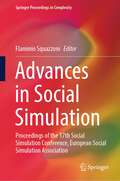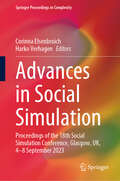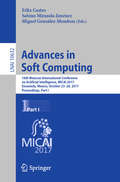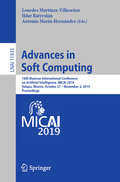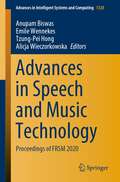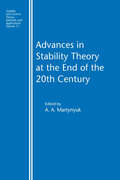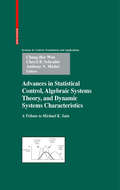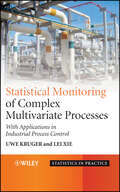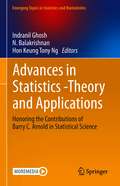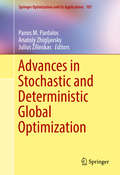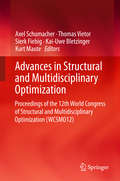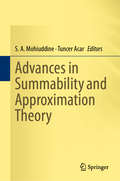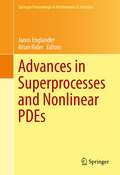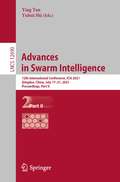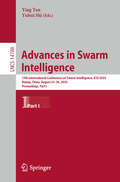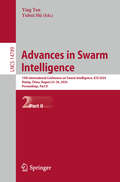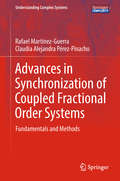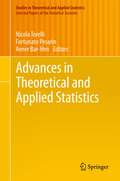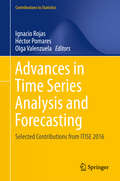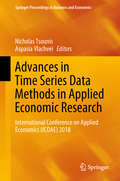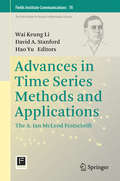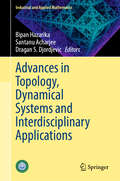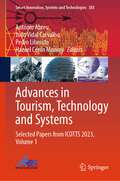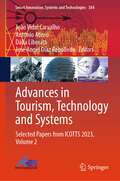- Table View
- List View
Advances in Social Simulation: Proceedings of the 17th Social Simulation Conference, European Social Simulation Association (Springer Proceedings in Complexity)
by Flaminio SquazzoniThis book highlights recent developments in the field of computer simulation and its application to social dynamics and behaviour. It covers latest advancements in the use of agent-based modelling by focusing on thematic issues, methodological progress and applications, including policy, industry and business. It aims to promote this interdisciplinary type of research by showing synergies, complementary and integration especially between computer sciences, social sciences, economics and organization, often bridging qualitative and quantitative research. The primary audience of this book are academics, practitioners and professionals using computer simulation for business counselling or industry.
Advances in Social Simulation: Proceedings of the 18th Social Simulation Conference, Glasgow, UK, 4–8 September 2023 (Springer Proceedings in Complexity)
by Corinna Elsenbroich Harko VerhagenThis book contains the proceedings of the 18th Social Simulation Conference (SSC) and covers the state of the art of social simulation modeling. The SSC is the annual conference of the European Social Simulation Association (ESSA) and the major global conference devoted to this topic. It is aimed at promoting social simulation and computational social science. The book is the biggest collection of agent-based modeling research. It covers all aspects of modeling, from theory and philosophy of modeling to question of model design, purpose, and structure, using data, visualization, model interrelation, and open modeling. This book is targeted at researchers in social simulation regardless of disciplinary backgrounds, across career stages and different sectors, such as academia, industry, and policy
Advances in Soft Computing: 16th Mexican International Conference on Artificial Intelligence, MICAI 2017, Enseneda, Mexico, October 23-28, 2017, Proceedings, Part I (Lecture Notes in Computer Science #10632)
by Sabino Miranda-Jiménez Félix Castro Miguel González-MendozaThe two-volume set LNAI 10632 and 10633 constitutes the proceedings of the 16th Mexican International Conference on Artificial Intelligence, MICAI 2017, held in Enseneda, Mexico, in October 2017. The total of 60 papers presented in these two volumes was carefully reviewed and selected from 203 submissions. The contributions were organized in the following topical sections: Part I: neural networks; evolutionary algorithms and optimization; hybrid intelligent systems and fuzzy logic; and machine learning and data mining. Part II: natural language processing and social networks; intelligent tutoring systems and educational applications; and image processing and pattern recognition.
Advances in Soft Computing: 18th Mexican International Conference on Artificial Intelligence, MICAI 2019, Xalapa, Mexico, October 27 – November 2, 2019, Proceedings (Lecture Notes in Computer Science #11835)
by Ildar Batyrshin Lourdes Martínez-Villaseñor Antonio Marín-HernándezThis volume constitutes the proceedings of the 18th Mexican Conference on Artificial Intelligence, MICAI 2019, held in Xalapa, Mexico, in October/November 2019. The 59 full papers presented in this volume were carefully reviewed and selected from 148 submissions. They cover topics such as: machine learning; optimization and planning; fuzzy systems, reasoning and intelligent applications; and vision and robotics.
Advances in Speech and Music Technology: Proceedings of FRSM 2020 (Advances in Intelligent Systems and Computing #1320)
by Tzung-Pei Hong Anupam Biswas Alicja Wieczorkowska Emile WennekesThis book features original papers from 25th International Symposium on Frontiers of Research in Speech and Music (FRSM 2020), jointly organized by National Institute of Technology, Silchar, India, during 8–9 October 2020. The book is organized in five sections, considering both technological advancement and interdisciplinary nature of speech and music processing. The first section contains chapters covering the foundations of both vocal and instrumental music processing. The second section includes chapters related to computational techniques involved in the speech and music domain. A lot of research is being performed within the music information retrieval domain which is potentially interesting for most users of computers and the Internet. Therefore, the third section is dedicated to the chapters related to music information retrieval. The fourth section contains chapters on the brain signal analysis and human cognition or perception of speech and music. The final section consists of chapters on spoken language processing and applications of speech processing.
Advances in Stability Theory at the End of the 20th Century (Stability and Control: Theory, Methods and Applications)
by A.A. MartynyukThis volume presents surveys and research papers on various aspects of modern stability theory, including discussions on modern applications of the theory, all contributed by experts in the field. The volume consists of four sections that explore the following directions in the development of stability theory: progress in stability theory by first approximation; contemporary developments in Lyapunov's idea of the direct method; the stability of solutions to periodic differential systems; and selected applications. Advances in Stability Theory at the End of the 20th Century will interest postgraduates and researchers in engineering fields as well as those in mathematics.
Advances in Statistical Bioinformatics: Models and Integrative Inference for High-Throughput Data
by Kim-Anh Do Zhaohui Steve Qin Marina VannucciProviding genome-informed personalized treatment is a goal of modern medicine. Identifying new translational targets in nucleic acid characterizations is an important step toward that goal. The information tsunami produced by such genome-scale investigations is stimulating parallel developments in statistical methodology and inference, analytical frameworks, and computational tools. Within the context of genomic medicine and with a strong focus on cancer research, this book describes the integration of high-throughput bioinformatics data from multiple platforms to inform our understanding of the functional consequences of genomic alterations. This includes rigorous and scalable methods for simultaneously handling diverse data types such as gene expression array, miRNA, copy number, methylation, and next-generation sequencing data. This material is written for statisticians who are interested in modeling and analyzing high-throughput data. Chapters by experts in the field offer a thorough introduction to the biological and technical principles behind multiplatform high-throughput experimentation.
Advances in Statistical Control, Algebraic Systems Theory, and Dynamic Systems Characteristics: A Tribute to Michael K. Sain (Systems & Control: Foundations & Applications)
by Anthony N. Michel Cheryl B. Schrader Chang-Hee WonThis volume is a collection of chapters covering recent advances in stochastic optimal control theory and algebraic systems theory. The book will be a useful reference for researchers and graduate students in systems and control, algebraic systems theory, and applied mathematics. Requiring only knowledge of undergraduate-level control and systems theory, the work may be used as a supplementary textbook in a graduate course on optimal control or algebraic systems theory.
Advances in Statistical Monitoring of Complex Multivariate Processes
by Uwe Kruger Lei XieThe development and application of multivariate statistical techniques in process monitoring has gained substantial interest over the past two decades in academia and industry alike. Initially developed for monitoring and fault diagnosis in complex systems, such techniques have been refined and applied in various engineering areas, for example mechanical and manufacturing, chemical, electrical and electronic, and power engineering. The recipe for the tremendous interest in multivariate statistical techniques lies in its simplicity and adaptability for developing monitoring applications. In contrast, competitive model, signal or knowledge based techniques showed their potential only whenever cost-benefit economics have justified the required effort in developing applications.Statistical Monitoring of Complex Multivariate Processes presents recent advances in statistics based process monitoring, explaining how these processes can now be used in areas such as mechanical and manufacturing engineering for example, in addition to the traditional chemical industry.This book:Contains a detailed theoretical background of the component technology.Brings together a large body of work to address the field's drawbacks, and develops methods for their improvement.Details cross-disciplinary utilization, exemplified by examples in chemical, mechanical and manufacturing engineering.Presents real life industrial applications, outlining deficiencies in the methodology and how to address them.Includes numerous examples, tutorial questions and homework assignments in the form of individual and team-based projects, to enhance the learning experience.Features a supplementary website including Matlab algorithms and data sets.This book provides a timely reference text to the rapidly evolving area of multivariate statistical analysis for academics, advanced level students, and practitioners alike.
Advances in Statistics - Theory and Applications: Honoring the Contributions of Barry C. Arnold in Statistical Science (Emerging Topics in Statistics and Biostatistics)
by N. Balakrishnan Hon Keung Tony Ng Indranil GhoshThis edited collection brings together internationally recognized experts in a range of areas of statistical science to honor the contributions of the distinguished statistician, Barry C. Arnold. A pioneering scholar and professor of statistics at the University of California, Riverside, Dr. Arnold has made exceptional advancements in different areas of probability, statistics, and biostatistics, especially in the areas of distribution theory, order statistics, and statistical inference. As a tribute to his work, this book presents novel developments in the field, as well as practical applications and potential future directions in research and industry. It will be of interest to graduate students and researchers in probability, statistics, and biostatistics, as well as practitioners and technicians in the social sciences, economics, engineering, and medical sciences.
Advances in Stochastic and Deterministic Global Optimization (Springer Optimization and Its Applications #107)
by Panos M. Pardalos Anatoly Zhigljavsky Julius ŽilinskasCurrent research results in stochastic and deterministic global optimization including single and multiple objectives are explored and presented in this book by leading specialists from various fields. Contributions include applications to multidimensional data visualization, regression, survey calibration, inventory management, timetabling, chemical engineering, energy systems, and competitive facility location. Graduate students, researchers, and scientists in computer science, numerical analysis, optimization, and applied mathematics will be fascinated by the theoretical, computational, and application-oriented aspects of stochastic and deterministic global optimization explored in this book. This volume is dedicated to the 70th birthday of Antanas Žilinskas who is a leading world expert in global optimization. Professor Žilinskas's research has concentrated on studying models for the objective function, the development and implementation of efficient algorithms for global optimization with single and multiple objectives, and application of algorithms for solving real-world practical problems.
Advances in Structural and Multidisciplinary Optimization: Proceedings of the 12th World Congress of Structural and Multidisciplinary Optimization (WCSMO12)
by Axel Schumacher Thomas Vietor Sierk Fiebig Kai-Uwe Bletzinger Kurt MauteThe volume includes papers from the WSCMO conference in Braunschweig 2017 presenting research of all aspects of the optimal design of structures as well as multidisciplinary design optimization where the involved disciplines deal with the analysis of solids, fluids or other field problems. Also presented are practical applications of optimization methods and the corresponding software development in all branches of technology.
Advances in Summability and Approximation Theory
by S. A. Mohiuddine Tuncer AcarThis book discusses the Tauberian conditions under which convergence follows from statistical summability, various linear positive operators, Urysohn-type nonlinear Bernstein operators and also presents the use of Banach sequence spaces in the theory of infinite systems of differential equations. It also includes the generalization of linear positive operators in post-quantum calculus, which is one of the currently active areas of research in approximation theory. Presenting original papers by internationally recognized authors, the book is of interest to a wide range of mathematicians whose research areas include summability and approximation theory.One of the most active areas of research in summability theory is the concept of statistical convergence, which is a generalization of the familiar and widely investigated concept of convergence of real and complex sequences, and it has been used in Fourier analysis, probability theory, approximation theory and in other branches of mathematics. The theory of approximation deals with how functions can best be approximated with simpler functions. In the study of approximation of functions by linear positive operators, Bernstein polynomials play a highly significant role due to their simple and useful structure. And, during the last few decades, different types of research have been dedicated to improving the rate of convergence and decreasing the error of approximation.
Advances in Superprocesses and Nonlinear PDEs (Springer Proceedings in Mathematics & Statistics #38)
by Janos Englander Brian RiderSergei Kuznetsov is one of the top experts on measure valued branching processes (also known as "superprocesses") and their connection to nonlinear partial differential operators. His research interests range from stochastic processes and partial differential equations to mathematical statistics, time series analysis and statistical software; he has over 90 papers published in international research journals. His most well known contribution to probability theory is the "Kuznetsov-measure." A conference honoring his 60th birthday has been organized at Boulder, Colorado in the summer of 2010, with the participation of Sergei Kuznetsov's mentor and major co-author, Eugene Dynkin. The conference focused on topics related to superprocesses, branching diffusions and nonlinear partial differential equations. In particular, connections to the so-called "Kuznetsov-measure" were emphasized. Leading experts in the field as well as young researchers contributed to the conference. The meeting was organized by J. Englander and B. Rider (U. of Colorado).
Advances in Swarm Intelligence: 12th International Conference, ICSI 2021, Qingdao, China, July 17–21, 2021, Proceedings, Part II (Lecture Notes in Computer Science #12690)
by Ying Tan Yuhui Shihis two-volume set LNCS 12689-12690 constitutes the refereed proceedings of the 12th International Conference on Advances in Swarm Intelligence, ICSI 2021, held in Qingdao, China, in July 2021. The 104 full papers presented in this volume were carefully reviewed and selected from 177 submissions. They cover topics such as: Swarm Intelligence and Nature-Inspired Computing; Swarm-based Computing Algorithms for Optimization; Particle Swarm Optimization; Ant Colony Optimization; Differential Evolution; Genetic Algorithm and Evolutionary Computation; Fireworks Algorithms; Brain Storm Optimization Algorithm; Bacterial Foraging Optimization Algorithm; DNA Computing Methods; Multi-Objective Optimization; Swarm Robotics and Multi-Agent System; UAV Cooperation and Control; Machine Learning; Data Mining; and Other Applications.
Advances in Swarm Intelligence: 15th International Conference on Swarm Intelligence, ICSI 2024, Xining, China, August 23–26, 2024, Proceedings, Part I (Lecture Notes in Computer Science #14788)
by Ying Tan Yuhui ShiThis two-volume set LNCS 14788 and 14789 constitutes the refereed post-conference proceedings of the 15th International Conference on Advances in Swarm Intelligence, ICSI 2024, held in Xining, China, during August 23–26, 2024. The 74 revised full papers presented in these proceedings were carefully reviewed and selected from 156 submissions. The papers are organized in the following topical sections: Part I - Particle swarm optimization; Swarm intelligence computing; Differential evolution; Evolutionary algorithms; Multi-agent reinforcement learning & Multi-objective optimization. Part II - Route planning problem; Machine learning; Detection and prediction; Classification; Edge computing; Modeling and optimization & Analysis of review.
Advances in Swarm Intelligence: 15th International Conference on Swarm Intelligence, ICSI 2024, Xining, China, August 23–26, 2024, Proceedings, Part II (Lecture Notes in Computer Science #14789)
by Ying Tan Yuhui ShiThis two-volume set LNCS 14788 and 14789 constitutes the refereed post-conference proceedings of the 15th International Conference on Advances in Swarm Intelligence, ICSI 2024, held in Xining, China, during August 23–26, 2024. The 74 revised full papers presented in these proceedings were carefully reviewed and selected from 156 submissions. The papers are organized in the following topical sections: Part I - Particle swarm optimization; Swarm intelligence computing; Differential evolution; Evolutionary algorithms; Multi-agent reinforcement learning & Multi-objective optimization. Part II - Route planning problem; Machine learning; Detection and prediction; Classification; Edge computing; Modeling and optimization & Analysis of review.
Advances in Synchronization of Coupled Fractional Order Systems: Fundamentals and Methods (Understanding Complex Systems)
by Rafael Martínez-Guerra Claudia Alejandra Pérez-PinachoAfter a short introduction to the fundamentals, this book provides a detailed account of major advances in applying fractional calculus to dynamical systems. Fractional order dynamical systems currently continue to gain further importance in many areas of science and engineering. As with many other approaches to mathematical modeling, the first issue to be addressed is the need to couple a definition of the fractional differentiation or integration operator with the types of dynamical systems that are analyzed. As such, for the fundamentals the focus is on basic aspects of fractional calculus, in particular stability analysis, which is required to tackle synchronization in coupled fractional order systems, to understand the essence of estimators for related integer order systems, and to keep track of the interplay between synchronization and parameter observation. This serves as the common basis for the more advanced topics and applications presented in the subsequent chapters, which include an introduction to the 'Immersion and Invariance' (I&I) methodology, the masterslave synchronization scheme for partially known nonlinear fractional order systems, Fractional Algebraic Observability (FAO) and Fractional Generalized quasi-Synchronization (FGqS) to name but a few. This book is intended not only for applied mathematicians and theoretical physicists, but also for anyone in applied science dealing with complex nonlinear systems.
Advances in Theoretical and Applied Statistics (Studies in Theoretical and Applied Statistics)
by Fortunato Pesarin Avner Bar-Hen Nicola TorelliThis volume includes contributions selected after a double blind review process and presented as a preliminary version at the 45th Meeting of the Italian Statistical Society. The papers provide significant and innovative original contributions and cover a broad range of topics including: statistical theory; methods for time series and spatial data; statistical modeling and data analysis; survey methodology and official statistics; analysis of social, demographic and health data; and economic statistics and econometrics.
Advances in Time Series Analysis and Forecasting: Selected Contributions from ITISE 2016 (Contributions to Statistics)
by Ignacio Rojas Héctor Pomares Olga ValenzuelaThis volume of selected and peer-reviewed contributions on the latest developments in time series analysis and forecasting updates the reader on topics such as analysis of irregularly sampled time series, multi-scale analysis of univariate and multivariate time series, linear and non-linear time series models, advanced time series forecasting methods, applications in time series analysis and forecasting, advanced methods and online learning in time series and high-dimensional and complex/big data time series. The contributions were originally presented at the International Work-Conference on Time Series, ITISE 2016, held in Granada, Spain, June 27-29, 2016. The series of ITISE conferences provides a forum for scientists, engineers, educators and students to discuss the latest ideas and implementations in the foundations, theory, models and applications in the field of time series analysis and forecasting. It focuses on interdisciplinary and multidisciplinary research encompassing the disciplines of computer science, mathematics, statistics and econometrics.
Advances in Time Series Data Methods in Applied Economic Research: International Conference On Applied Economics (icoae) 2018 (Springer Proceedings in Business and Economics)
by Nicholas Tsounis Aspasia VlachveiThis conference proceedings volume presents advanced methods in time series estimation models that are applicable various areas of applied economic research such as international economics, macroeconomics, microeconomics, finance economics and agricultural economics. Featuring contributions presented at the 2018 International Conference on Applied Economics (ICOAE) held in Warsaw, Poland, this book presents contemporary research using applied econometric method for analysis as well as country specific studies with potential implications on economic policy. Applied economics is a rapidly growing field of economics that combines economic theory with econometrics to analyse economic problems of the real world usually with economic policy interest. ICOAE is an annual conference started in 2008 with the aim to bring together economists from different fields of applied economic research in order to share methods and ideas. Approximately 150 papers are submitted each year from about 40 countries around the world. The goal of the conference and the enclosed papers is to allow for an exchange of experiences with different applied econometric methods and to promote joint initiatives among well-established economic fields such as finance, agricultural economics, health economics, education economics, international trade theory and management and marketing strategies. Featuring global contributions, this book will be of interest to researchers, academics, professionals and policy makers in the field of applied economics and econometrics.
Advances in Time Series Methods and Applications: The A. Ian McLeod Festschrift (Fields Institute Communications #78)
by Hao Yu Wai Keung Li David A. StanfordThis volume reviews and summarizes some of A. I. McLeod's significant contributions to time series analysis. It also contains original contributions to the field and to related areas by participants of the festschrift held in June 2014 and friends of Dr. McLeod. Covering a diverse range of state-of-the-art topics, this volume well balances applied and theoretical research across fourteen contributions by experts in the field. It will be of interest to researchers and practitioners in time series, econometricians, and graduate students in time series or econometrics, as well as environmental statisticians, data scientists, statisticians interested in graphical models, and researchers in quantitative risk management.
Advances in Topology, Dynamical Systems and Interdisciplinary Applications (Industrial and Applied Mathematics)
by Bipan Hazarika Santanu Acharjee Dragan S. DjordjevicThis book contains selected chapters on topology and dynamical systems and their interdisciplinary applications. Targeting researchers in interdisciplinary areas, the book covers contemporary interdisciplinary topics in topology and dynamical systems, such as closure functions, Partially Negative Dimensional Product (PNDP) manifolds, Khalimsky topological subspaces, neutrosophic topological space, ideal topological spaces, relator spaces, predator–prey symbiosis, cosmological models, and nanofluids.
Advances in Tourism, Technology and Systems: Selected Papers from ICOTTS 2023, Volume 1 (Smart Innovation, Systems and Technologies #383)
by António Abreu Pedro Liberato João Vidal Carvalho Hazael Cerón MonroyThis book features a collection of high-quality research papers presented at the International Conference on Tourism, Technology and Systems (ICOTTS 2023), held at Anáhuac University, Bacalar, Mexico, from 2 to 4 November 2023. The book is divided into two volumes, and it covers the areas of technology in tourism and the tourist experience, generations and technology in tourism, digital marketing applied to tourism and travel, mobile technologies applied to sustainable tourism, information technologies in tourism, digital transformation of tourism business, e-tourism and tourism 2.0, big data and management for travel and tourism, geotagging and tourist mobility, smart destinations, robotics in tourism, and information systems and technologies.
Advances in Tourism, Technology and Systems: Selected Papers from ICOTTS 2023, Volume 2 (Smart Innovation, Systems and Technologies #384)
by António Abreu Dália Liberato João Vidal Carvalho José Angel Díaz RebolledoThis book features a collection of high-quality research papers presented at the International Conference on Tourism, Technology and Systems (ICOTTS 2023), held at Anáhuac University, Bacalar, Mexico, from 2 to 4 November 2023. The book is divided into two volumes, and it covers the areas of technology in tourism and the tourist experience, generations and technology in tourism, digital marketing applied to tourism and travel, mobile technologies applied to sustainable tourism, information technologies in tourism, digital transformation of tourism business, e-tourism and tourism 2.0, big data and management for travel and tourism, geotagging and tourist mobility, smart destinations, robotics in tourism, and information systems and technologies.
